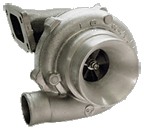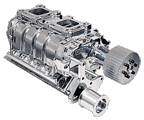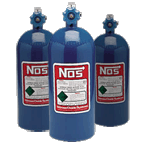Boost Training
Information on Force Inducation Systems
Force Inducation Overview
One of the primary factors affecting engine performance as the ability to get as much of the air and fuel mixture into the engine as possible. It can be thought of as the engines ability to "inhale or asperate".
In order to produce power, an engine requires a fuel and air mixture to be mixed together and then brought into the cycle, compressed and ignited. The concept of forced induction is essentially a method wherein we literally compress the air (oxygen) before we bring it into the process of combustion.
So basically, think of an engine as a person who is gasping for air after a long run down the street. This person is gasping because they are trying to circulate as much air as possible through their lungs. Now imagine if you were able to force more air into their lungs then they would otherwise be able to suck in on their own. This would in turn help them out very much. In fact, it would help them so much that they would probably be able to run for a lot longer without having to stop in order to "catch their breath". In turn, this would yield greater performance.
So basically, you can pretty much parallel this idea to an engine. The more air you get into it, the more performance you'll get out of it. This is where the concept of forced induction was derived.
While different systems have been designed to achieve the same result (Turbochargers, Superchargers etc.) the overall function is the same, to compress additonal air (oxygen) into the cylender(s) so more fuel can be added (the air/fuel ration most stay the same). This additional press forcing air into the cylinder is pre fered to a "Boost". Most engines run in a vacume, where the openning cyclinder draws (sucks) air and fuel into it. When at Boost air and fuel is forced into the cyclinder. Which means the cyclinder can be filled and pressuredized during the intake cycle (see 4 Stroke Engine).
One of the primary factors affecting engine performance as the ability to get as much of the air and fuel mixture into the engine as possible. It can be thought of as the engines ability to "inhale or asperate".
In order to produce power, an engine requires a fuel and air mixture to be mixed together and then brought into the cycle, compressed and ignited. The concept of forced induction is essentially a method wherein we literally compress the air (oxygen) before we bring it into the process of combustion.
So basically, think of an engine as a person who is gasping for air after a long run down the street. This person is gasping because they are trying to circulate as much air as possible through their lungs. Now imagine if you were able to force more air into their lungs then they would otherwise be able to suck in on their own. This would in turn help them out very much. In fact, it would help them so much that they would probably be able to run for a lot longer without having to stop in order to "catch their breath". In turn, this would yield greater performance.
So basically, you can pretty much parallel this idea to an engine. The more air you get into it, the more performance you'll get out of it. This is where the concept of forced induction was derived.
While different systems have been designed to achieve the same result (Turbochargers, Superchargers etc.) the overall function is the same, to compress additonal air (oxygen) into the cylender(s) so more fuel can be added (the air/fuel ration most stay the same). This additional press forcing air into the cylinder is pre fered to a "Boost". Most engines run in a vacume, where the openning cyclinder draws (sucks) air and fuel into it. When at Boost air and fuel is forced into the cyclinder. Which means the cyclinder can be filled and pressuredized during the intake cycle (see 4 Stroke Engine).
Forced Inducation Systems
| |||
Forced Air Systems |
Gas Fogger Systems | ||
 |
 |
 |
 |
Calculating Boost
- RB Racing offers several dynamic online calculators, with full explanations, for Boost Compression Ratio, Intercooler Efficiency, Fuel Injection, and several other key subjects to help set up and design turbo motorcycles. RB Racing has been turbocharging vehicles since 1979 and offer a great amount of insight into the subject. Click Here
- Old school style manifold pressure charts (Printable). Calculate estimated horsepower and effective compression ratio from set boost amounts, based on manifold pressure. Local altitude and relevant pressure may cause the accuracy of charts to vary on the same principal as a Dyno test. Click Here
- Plenum chamber sizing. Taken from the book Turbochargers by Hugh MacInnes Click Here
To convert BAR (KGS) to PSI (Lbs.): 14.5037 X The amount of BAR (KGS)
To convert PSI (Lbs.) to BAR (KGS): 0.068948 X The amount of PSI (Lbs.)
To convert PSI (Lbs.) to BAR (KGS): 0.068948 X The amount of PSI (Lbs.)
